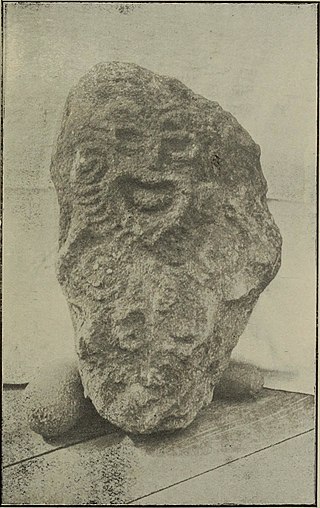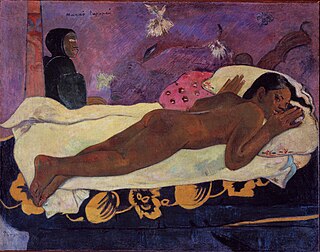Related Research Articles

Polynesian mythology encompasses the oral traditions of the people of Polynesia together with those of the scattered cultures known as the Polynesian outliers. Polynesians speak languages that descend from a language reconstructed as Proto-Polynesian – probably spoken in the Tonga and Samoa area around 1000 BC.

In Māori mythology, Rongo or Rongo-mā-Tāne is a major god (atua) of cultivated plants, especially kumara, a vital crop. Other crops cultivated by Māori in traditional times included taro, yams (uwhi), cordyline (tī), and gourds (hue). Because of their tropical origin, most of these crops were difficult to grow except in the far north of the North Island, hence the importance of Rongo in New Zealand.

In Māori mythology the primal couple Rangi and Papa appear in a creation myth explaining the origin of the world and the Māori people. In some South Island dialects, Rangi is called Raki or Rakinui.
Tangaroa is the great atua of the sea, lakes, rivers, and creatures that live within them, especially fish, in Māori mythology. As Tangaroa-whakamau-tai he exercises control over the tides. He is sometimes depicted as a whale.
In Polynesian languages the word aitu refers to ghosts or spirits, often malevolent. The word is common to many languages of Western and Eastern Polynesia. In the mythology of Tonga, for example, ʻaitu or ʻeitu are lesser gods, many being patrons of specific villages and families. They often take the form of plants or animals, and are often more cruel than other gods. These trouble-making gods are regarded as having come from Samoa. The Tongan word tangi lauʻaitu means to cry from grief, to lament.
Atea is a deity in several Polynesian cultures, including the Marquesas and Tuamotu Islands, and New Zealand.

Auraka is a locality in the Keia district, on the western side of the island of Mangaia in the Cook Islands. The Keia district contains at least two ancient burial caves, Kauvava and Piri Te Umeume, which were accessed by diagonal descents through boulder-strewn roof collapses from the top of the makatea, the limestone cliffs that form a concentric ring around the central basalt core of the island. Gill, an early source for the mythology of Mangaia, noted a cave in Keia named Auraka, with one of its two entrances named Kauvava (1876a:71–79). However, according to Anton and Steadman, Gill's "description of the physical features of this cave does not match that of the cave currently known as Kauvava". Gill describes Auraka as a cave which is the 'last resting-place of the dead'.
In a tradition of the Moriori people of the Chatham Islands, Rohe is the wife of the demi-god Māui. Beautiful Rohe was a sister of the sun, and her face shone. A quarrel arose after Rohe remarked that Māui's face was ugly. Māui then decided that they should change faces.
Miru is a goddess in the Polynesian mythology of the Cook Islands who lives in Avaiki beneath Mangaia. She feeds the souls of dead people a bowl of live centipedes, causing them to writhe in agony, then encourages them to seek relief by diving into a lake, where they drown and can be cooked and eaten at her leisure. The Tapairu are her daughters, and Tau-Titi is her son.
In the mythology of Mangaia in the Cook Islands, the Tapairu are elves or fairies, who are named after the four daughters of Miru, the deformed goddess of the underworld. They were said to have been present when mortals danced in honor of their brother, Tau-Titi. They were also associated with the god Tane.

In Cook Islands mythology, Avatea was a lunar deity and the father of gods and men in Mangaian myth of origin. His eyes were thought to be the Sun and the Moon; he was also known as the god of light.
In the mythology of Mangaia in the Cook Islands, Moko is a wily character and grandfather of the heroic Ngaru.
Ngaru is a mythological hero from Avaiki (Hawaiki) in the mythology of Mangaia in the Cook Islands. Ngaru's mother was Vaiare and his grandfather the great lizard Moko. His wife was the beautiful Tongatea. To prove his prowess, he battles Tikokura and the shark Tumuitearetoka, who he outwits with the aid of Moko. he later descends to the underworld and returns to the land of the living where he subsequently defeats the sky fairies and Amai-te-rangi, a sky demon.
In Polynesian mythology, Tuna is a god of eels. In Hawaiian mythology he fights with Māui, who is having an affair with his wife Hina. Māui kills him, cuts off his head, and plants it near his home. A green shoot emerges from the spot where the head was buried, and grows into the first coconut palm. In the mythology of Mangaia Tuna is the lover of Hine, and asks that his head be cut off and planted in order to stop a flood. A coconut shoot grows from the head. A variant of the story is told in the Samoan myth of Sina and the Eel.

Mangaia is the most southerly of the Cook Islands and the second largest, after Rarotonga. It is a roughly circular island, with an area of 51.8 square kilometres (20.0 sq mi), 203 kilometres (126 mi) from Rarotonga. Originally heavily populated, Mangaia's population has dropped by 75% in the last 50 years.
Tangaloa was an important family of gods in Tongan mythology. The first Tangaloa was the cousin of Havea Hikuleʻo and Maui, or in some sources the brother or son or father of them. He was Tangaloa ʻEiki, and was assigned by his father, Taufulifonua, the realm of the sky to rule.
Tui Tokelau is a god worshipped in Tokelau in the Pacific. Before the arrival of Christianity in the islands, Tui Tokelau was the primary god along with the usual pantheon of Polynesian gods. The marae of the village of Fakaofo on Fakaofo atoll was the location of a house that contained a monumental coral slab personifying Tui Tokelau, which was covered with beautiful mats. The principal chief (ariki) was the chief priest. During the month of May, all the people of the islands of Tokelau assembled at Fakaofo, and prepared a feast, and prayed to Tui Tokelau to protect them. This ceremony represented the new year. The ceremonial proceedings during May included offerings of fish, coconuts and pandanus drupes. A fire was lit in the temple, and the people danced during the night.

Sina and the Eel is a myth of origins in Samoan mythology, which explains the origins of the first coconut tree.

There was widespread belief in ghosts in Polynesian culture, some of which persists today. After death, a person's ghost would normally travel to the sky world or the underworld, but some could stay on earth. In many Polynesian legends, ghosts were often involved in the affairs of the living. Ghosts might also cause sickness or even invade the body of ordinary people, to be driven out through strong medicines.

Cook Islands mythology comprises historical myths, legends, and folklore passed down by the ancient Cook Islanders over many generations. Many of the Cook Islands legends were recited through ancient songs and chants. The Cook Islands myths and legends have similarities to general Polynesian mythology, which developed over the centuries into its own unique character.
References
- ↑ William Wyatt Gill (1876). Myths and Songs from the South Pacific. H. S. King & Company. p. 19.
Motoro.
- ↑ The Journal of the Polynesian Society. Polynesian Society. 1911. p. 143.
Motoro.
- 1 2 Te Rangi Hiroa. Mangaian Society. p. 22 – via NZETC.
- ↑ Johannes C. Andersen (1969). Myths & Legends of the Polynesians. Tokyo: Tuttle. p. 349.